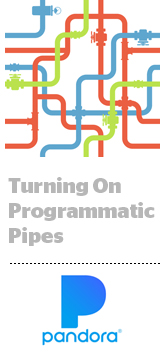
Call it fashionably late: Pandora has finally showed up to the programmatic audio party.
The digital audio platform said Tuesday buyers can now purchase its audio inventory programmatically through a private marketplace (PMP) via The Trade Desk, MediaMath and AdsWizz’s AudioMatic DSP. Pandora is testing the PMP in a pilot program with five to 10 Omnicom Media Group clients, including Volkswagen, said Chris Record, SVP of revenue operations at Pandora.
“We want to gain some early learnings and build upon successes as we build the channel further and then get out that full availability offering,” he said.
Record said spend flowing through the PMP is in the six figures. He did not share when the PMP will open to all advertisers.
Pandora’s foray into programmatic audio has been a long time coming. IHeartRadio launched the first PMP for programmatic audio with AdsWizz in 2014. Spotify followed with its own programmatic audio PMP working with The Trade Desk, AppNexus and Rubicon Project in July 2016.
Pandora, meanwhile, has rolled out programmatic for display and video the past couple of years, but it has been slower than its peers with other programmatic products because it had legacy ad-buying systems and lacked the right relationships with advertisers. As the marketplace matures, Pandora wants to leverage its scale – it has about 73 million monthly active users in the US.
“We’ve been working on updating our programmatic infrastructure for quite some time now,” said Eric Picard, VP of product management at Pandora. “When you look at the amount of inventory volume we have, it’s pretty clear those are the two key pieces that have hurt the adoption of audio in the programmatic space.”
Now that Pandora can sell audio programmatically, it will become easier for buyers to transact. Advertisers can’t pool Pandora inventory with, say, Spotify inventory in the same buy. But, using the Trade Desk – which works with both publishers – ad buyers can get aggregated reporting or coordinate creative across both platforms.
Buyers using Pandora’s PMP will be able to leverage its 2,000 proprietary audience segments based on the data it gleans from the listening habits of its logged-in user base. Marketers will be able to bring first-party and CRM data to their buys, although they may want to wait until Pandora releases more inventory into the marketplace so they can target granularly at scale, Picard said.
“Finding small pools of inventory, especially as you start layering targeting data onto geography, starts to get very tight,” he said. “Opening that up at high scale is something we’re looking into. Before we open the floodgates for all demand, we need to make sure that we’re understanding how all of the different systems interact.”
Pandora said it’s entering programmatic cautiously because flooding the market with audio supply can drive down prices, Picard said.
“Things haven’t scaled from a volume perspective the way the market has wanted in the audio space,” he said. “The main component of this has been to not just step in and offer a remnant solution.”
Pandora’s entrance into programmatic audio reaffirms the importance of advertising to its business model. Despite launching an on-demand subscription service in December 2016, the business remains primarily ad-funded, Picard said. Ad revenue, however, was flat at Pandora in Q3 2017 as buyers started to pull away from the platform because it lacked a programmatic solution.
“If you look at some other services in the market, the ad-funded tier is an entry-level tier designed to transition someone to a subscription tier as quickly as possible,” Picard said. “We’re building a very healthy, sustainable, long-term, ad-funded business.”
Agencies are pleased with Pandora’s programmatic audio capability, especially as audio becomes a bigger focus for brands, said Emily Kramer, senior director of media at Merkle. To catch up to the rest of the marketplace, Pandora will have to open its inventory to more top-tier DSPs and scale its quality inventory, she added.
“As audio becomes more scaled, accessible and important – especially as voice-controlled devices continue to enter the market – it is not a secondary consideration as part of our client’s initiatives,” she said in an email to AdExchanger. “The more inventory that can be purchased through programmatic channels, the better.”
Pandora reports fourth-quarter and full-year 2017 earnings on Wednesday.
This post was syndicated from Ad Exchanger.

More Stories
Here’s My Beef With Ad Agencies
Retreat To MMM
Indulge anytime, anywhere: Puhoi Valley delivers A Little Bit of Naughty